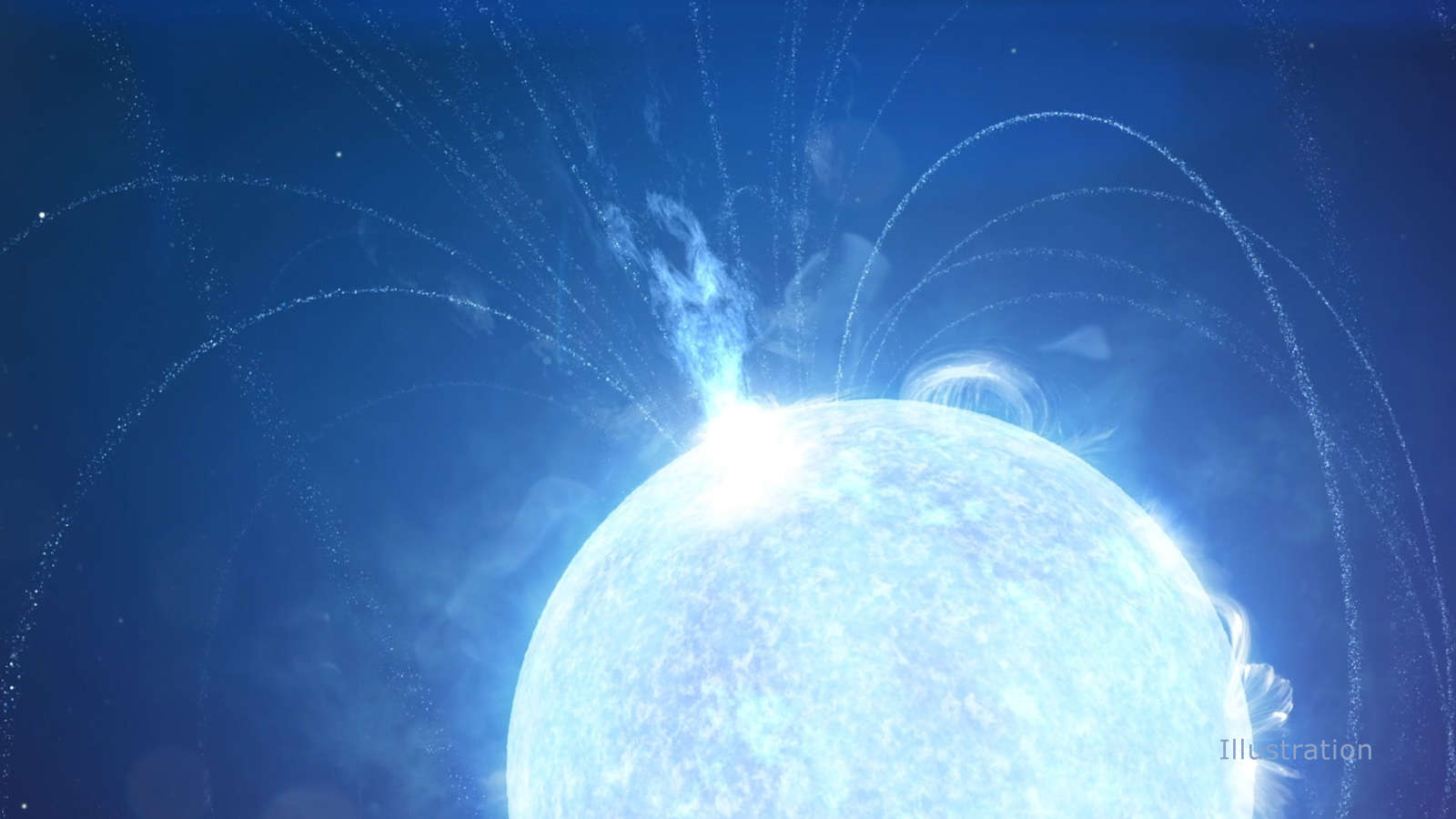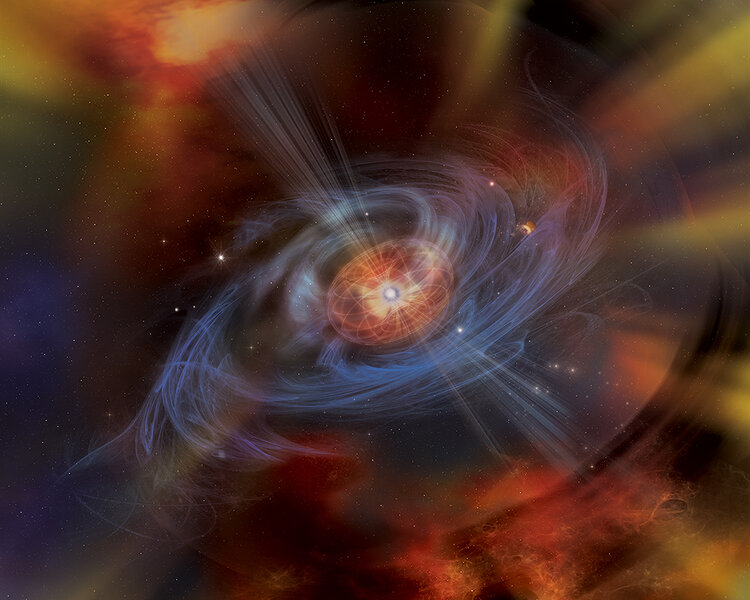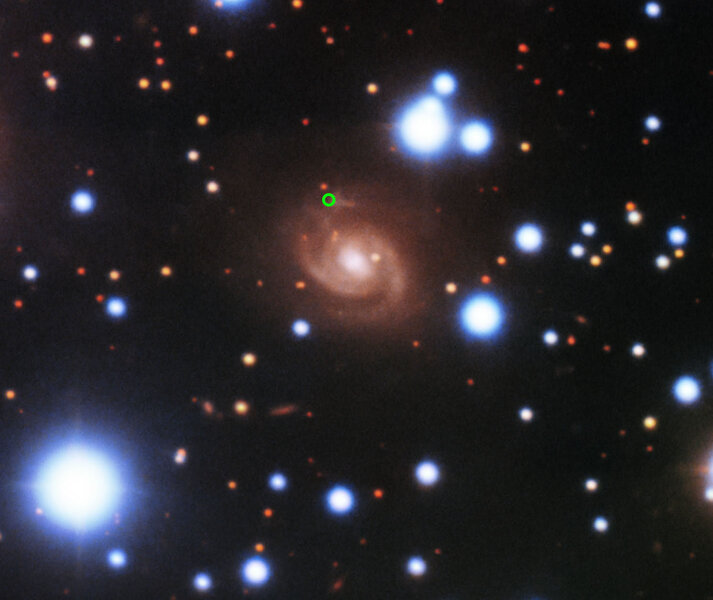Create a free profile to get unlimited access to exclusive videos, sweepstakes, and more!
Breakthrough! Mysterious radio signal traced to a galactic minimonster

Astronomers have announced what may be a big breakthrough in the study of mysterious and hugely powerful blasts of energy called Fast Radio Bursts. Up to hundreds of millions of times brighter than the Sun, these fierce explosions last only a millisecond, and are fiendishly hard to study. Up to now they have always been seen in distant galaxies, but one detected in April 2020 came from inside our own galaxy, and has been traced to one of the most terrifying objects in space: a magnetar.
The first Fast Radio Burst (or FRB to their friends) was discovered in 2007 — although it happened in 2001, it was found later in archived data. Since then over a hundred more have been detected. They pretty much are as advertised by their names: An extremely fast (usually millisecond range) flash of radio waves. They've been difficult to study because they're so brief, and come from scattered places across the sky.
A breakthrough was made a few years ago when some were found to repeat, meaning follow-up observations could be made. That was also a big clue to their origin; something that explodes catastrophically and destroys itself can't repeat, so it's not some weird kind of supernova. Another important finding was one that was traced to a spiral galaxy 500 million light years away. Getting a distance is crucial, because that can tell you the total energy emitted by the event. That narrows down suspects. Even better, that one was a repeater with a 16-day cycle to its bursts.
That sounds like an orbital period, so now we're talking compact objects. Given the vast energies involved and the incredibly brief flash, astronomers starting thinking about neutrons stars: super-dense remnants of supernova explosions, with a mass more than that of the Sun squeezed down into a ball just a dozen kilometers or so across.
Neutron stars have incredibly powerful magnetic fields, just hair-raisingly ridiculously powerful. A newborn neutron star can have a magnetic field a quadrillion times more powerful than Earth's. A quadrillion. That's 1,000,000,000,000,000 times. We call such beasts magnetars.
Also, the surface gravity on a neutron star can be tens of billions of times the Earth's. If you stood on one you'd be smeared into a paste one atom thick, and then those atoms would be ionized by the heat, and then they'd be stirred up violently by the magnetic fields.
So, yeah, magnetars are beasts. And it gets worse: Sometimes they suffer a "starquake," where the crust shifts by a centimeter or so. Not much, but at those densities and strong gravity these dwarf the most powerful earthquake ever felt. This shakes the magnetic field, accelerating subatomic particles there. Those in turn create a blast of energy so powerful I can't even describe it. In 2004, a wave of energy from a magnetar swept over the Earth, blinding satellites, physically compressing our magnetic field, and even affecting our atmosphere, and that magnetar was 50,000 light years away. Read all about that event, if you dare.
This makes them perfect candidates for the sources of FRBs, but up until now it wasn't possible to make that connection.
The new event, called FRB200428A (it happened in 2020 on April 28; the A is to distinguish it from any other event that might have happened that day), was detected by a collection of three radio observatories called STARE2 (the Survey for Transient Astronomical Radio Emission 2). It was seen at the same time by another radio observatory called CHIME (Canadian Hydrogen Intensity Mapping Experiment). They were able to localize the event in the sky to a known magnetar in the constellation of Vulpecula called SGR 1935+2154.
That's a big deal already, but it gets better. That same magnetar was seen to give off a pair of X-ray flashes just the day before by the Swift satellite. Shortly thereafter other space-based observatories reported seeing an X-ray flash from that magnetar as well.
The magnetar is about 30,000 light years away, quite a large fraction across the galaxy from us. Given that distance, the total energy released (assuming it was emitted in all directions) is a staggering 100,000 times the energy the Sun emits in a comparable time. It was thousands of times more powerful than any such millisecond radio burst ever seen in our Milky Way galaxy before.
Amazingly, that's actually fairly weak for an FRB! Most are a thousand times that powerful, but given the duration and energy involved, this event fits better with FRBs than other similar events. Interestingly, this appears to be in the one-and-done class of FRBs; 448 total days of observations before and after the event show no signs of another such burst.
SGR 1935+2154 is known to sit in the center of the expanding shell of gas from a supernova, a star that exploded long ago. Several other FRBs have been localized to similar places in their host galaxies, again supporting the idea that magnetars are tied to FRBs.
So this is a very big deal. Still, mysteries remain. Why did it flare in X-rays hours before the radio burst? Interestingly, theory predicts the FRB should come just before an X-ray flash, and indeed the X-ray flash should de-energize the magnetar enough to make an FRB after it pretty unlikely. Also, why have no other bursts been seen from it, or from any of the 2+ dozen magnetars known to exist in our Milky Way? The authors of the new paper offer some fairly complex explanations involving huge blasts of energy interacting with the magnetar's magnetic field, but none seems to explain everything seen in this event.
The important part, though, is the linking of FRBs with magnetars. That's cool, because they fit with many FRBs seen in other galaxies, including the energies involved, the periodicity (magnetars could easily be in orbit with other stars), and more.
But even that is interesting, because the most powerful FRBs may be due to some other type of phenomenon. That happens a lot in astronomy; relatively similar events can have wildly different sources, so nailing down one particular source doesn't mean you understand what causes all these events.
But this does mean that weaker FRBs may be detectable in nearby galaxies. I expect astronomers will work on dedicated observations of some of our galactic neighbors, to see if perhaps extragalactic events like this one are within our ability to spot.
This is an entirely new class of event, and we've only been seeing them for 13 years! So it's early days yet, and I expect there are plenty of surprises lying ahead as more are found. That's part of what makes FRBs so exciting, and so fun.
If vast explosions from über-dense hypergravitational magnetic superstars is your idea of fun. For astronomers, it really is.





























